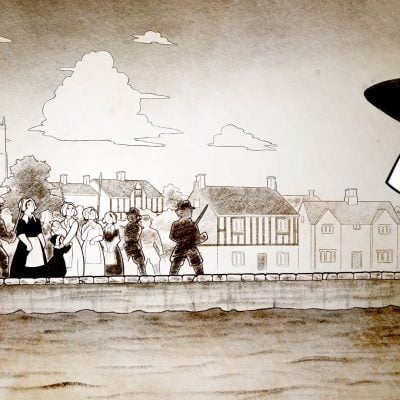
Separatists forced to live secret lives
Religious life changed dramatically throughout the course of the 15th and 16th century. As each monarch changed, there were big changes in the way the Church expected people to practise their faith – and everyone was expected to follow the Church’s rules. If you didn’t, you were likely to find yourself before the Church courts facing a fine or worse.
With each change in the monarchy, different people were affected – sometimes the Catholics were in charge, sometimes the Protestants:
- Henry VIII, 1509-47: Catholic English Church splits from the Roman Catholic Church
- Edward VI, 1547-53: England becomes Protestant under Henry’s son
- Mary I, 1553-8: Henry’s daughter brings back Catholicism
- Elizabeth I, 1558-1603: Henry’s other daughter brings back Protestantism
- James I, 1603-1625: Protestant King of Scotland becomes King of England too – Protestant Puritans hope he will reform the Church even more.
Even when there was a Protestant monarch, there were different rules. As King James I came to the throne in the early 1600s, many of the Puritans (strict Protestants) hoped that he would reform the Church and rid it of traditions they associated with the Catholic Church.
When James didn’t act in the way they’d hoped, then some of these Puritans decided they had little choice but to form their own churches – and this is what the Gainsborough Separatists did. They were forced to meet in secret to avoid attracting attention from the authorities and for their own safety.
In his diary, Pilgrim William Bradford recalled their troubles and resolve in the face of what he saw as a moral choice because of how strongly they objected to the way the Church was evolving under King James:
They shook off this yoke of antichristian bondage, and as the Lord’s free people, joined themselves … into a church estate … according to their best endeavours, whatsoever it should cost them, the Lord assisting them. And that it cost them something this ensuing history will declare.
Bradford then describes how two congregations were formed, before giving us a sense of what their lives must have been like, worshiping and meeting together in secret. They were ‘hunted and persecuted’, and ‘clapped up in prison’, while others had their houses watched.
Although Bradford says that the Pilgrims were prepared for all this thanks to their faith, they still reached a point where they decided they couldn’t stand to stay in England anymore:
Seeing themselves thus molested, and that there was no hope of their continuance there, by a joint consent they resolved to go into the Low-Countries, where they heard was freedom of Religion for all men; as also how [some] from London, & other parts of the land, had been exiled and persecuted for the same cause, & were gone [there], and lived at Amsterdam, & in other places of the land.
So after they had continued together about a year, and kept their meetings every Sabbath in one place or other, exercising the worship of God amongst themselves, notwithstanding all the diligence & malice of their adversaries, they seeing they could no longer continue in that condition, they resolved to get over into Holland as they could; which was in the year 1607 & 1608.
Next week: Escape#1 – the Pilgrims make their way to Boston for their first attempt at escaping England.


